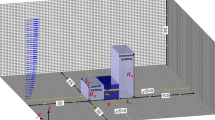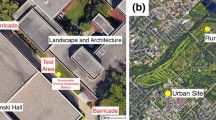Abstract
During sunny days with periods of low synoptic wind, buoyancy forces can play a critical role on the air flow, and thus on the dispersion of pollutants in the built urban environments. Earlier studies provide evidence that when a surface inside an urban street canyon is at a higher temperature than that of local ambient air, buoyancy forces can modify the mechanically-induced circulation within the canyons (i.e., gaps between buildings). The aspect ratio of the urban canyon is a critical factor in the manifestation of the buoyancy parameter. In this paper, computational fluid dynamics simulations are performed on urban street canyons with six different aspect ratios, focusing on the special case where the leeward wall is at a greater temperature than local ambient air. A non-dimensional measure of the influence of buoyancy is used to predict demarcations between the flow regimes. Simulations are performed under a range of buoyancy conditions, including beyond those of previous studies. Observations from a field experiment and a wind tunnel experiment are used to validate the results.









Similar content being viewed by others
References
Allegrini J, Dorer V, Carmeliet J (2013) Wind tunnel measurements of buoyant flows in street canyons. Build Environ 59:315–326
ANSYS Inc. (2012) ANSYS Fluent 14.0 Theory Guide
Britter RE, Hanna SR (2003) Flow and dispersion in urban areas. Ann Rev Fluid Mech 35(1):469–496
Cai X (2012) Effects of wall heating on flow characteristics in a street canyon. Bound-Lay Meteorol 142(3):443–467
Cai X (2012) Effects of differential wall heating in street canyons on dispersion and ventilation characteristics of a passive scalar. Atmos Environ 51:268–277
Castro IP, Robins AG (1977) The flow around a surface-mounted cube in uniform and turbulent streams. J Fluid Mech 79(02):307–335
Dallman A, Magnusson S, Britter RE, Norford L, Entekhabi D, Fernando HJS (2014) Conditions for thermal circulation in urban street canyons. Build Environ
Department of Economic and Social Affairs (UN DESA). (2012) World Urbanization Prospects 2011 highlights. Technology. http://www.slideshare.net/undesa/wup2011-highlights Accessed 30 Apr 2012
Fernando HJS, Zajic D, Di Sabatino S, Dimitrova R, Hedquist B, Dallman A (2010) Flow, turbulence, and pollutant dispersion in urban atmospheres. Phys Fluids 22(5):051301
Kim JJ, Baik JJ (1999) A numerical study of thermal effects on flow and pollutant dispersion in urban street canyons. J Appl Meteorol 38(9):1249–1261
Kim JJ, Baik JJ (2004) A numerical study of the effects of ambient wind direction on flow and dispersion in urban street canyons using the RNG k-\(\varepsilon \) turbulence model. Atmos Environ 38(19):3039–3048
Li XX, Britter RE, Koh TY, Norford L, Liu CH, Entekhabi D, Leung DYC (2010) Large-Eddy simulation of flow and pollutant transport in urban street canyons with ground heating. Bound-Lay Meteorol 137(2):187–204
Li XX, Britter RE, Norford L, Koh TY, Entekhabi D (2012) Flow and pollutant transport in urban street canyons of different aspect ratios with ground heating: Large-Eddy simulation. Bound-Lay Meteorol 142:289–304
Look P, Belcher S, Harrison R (2000) Coupling between air flow in streets and the well-developed boundary layer aloft. Atmos Environ 34(16):2613–2621
Louka P, Vachon G, Sini JF, Mestayer PG, Rosant JM (2002) Thermal effects on the airflow in a street canyon—Nantes’99 experimental results and model simulations. Water Air Soil Pollut 2(5–6):351–364
Oke TR (1988) Street design and urban canopy layer climate. Energy Build 11(1):103
Park SB, Baik JJ, Raasch S, Letzel MO (2012) A Large-Eddy simulation study of thermal effects on turbulent flow and dispersion in and above a street canyon. J Appl Meteorol Climatol 51(5):829–841
Richards PJ, Hoxey RP (1993) Appropriate boundary conditions for computational wind engineering models using the \(k-\epsilon \) turbulence model. J Wind Eng Ind Aerodyn 46–47:145–153
Sini JF, Anquetin S, Mestayer PG (1996) Pollutant dispersion and thermal effects in urban street canyons. Atmos Environ 30(15):2659–2677
Solazzo E, Britter RE (2007) Transfer processes in a simulated urban street canyon. Bound-Lay Meteorol 124(1):43
Stull RB (1988) An Introduction to boundary layer meteorology. Springer, Berlin and New York
Turner JS (1979) Buoyancy effects in fluids. Cambridge University Press, Cambridge
Acknowledgments
This research was supported by the Singapore National Research Foundation through the Singapore-MIT Alliance for Research and Technology’s Center for Environmental Sensing and Modeling (CENSAM). During the preparation of this paper, H.J.S. Fernando was supported by National Science Foundation (CMG; Grant # 0934592). The authors would like to thank the two reviewers for their useful comments and suggestions.
Author information
Authors and Affiliations
Corresponding author
Rights and permissions
About this article
Cite this article
Magnusson, S., Dallman, A., Entekhabi, D. et al. On thermally forced flows in urban street canyons. Environ Fluid Mech 14, 1427–1441 (2014). https://doi.org/10.1007/s10652-014-9353-4
Received:
Accepted:
Published:
Issue Date:
DOI: https://doi.org/10.1007/s10652-014-9353-4




